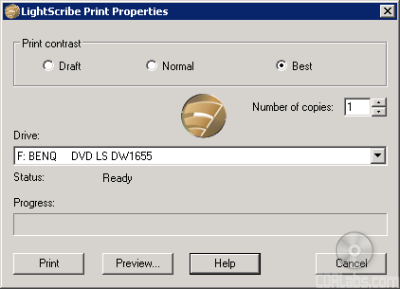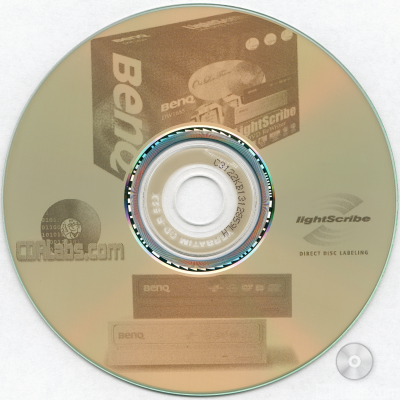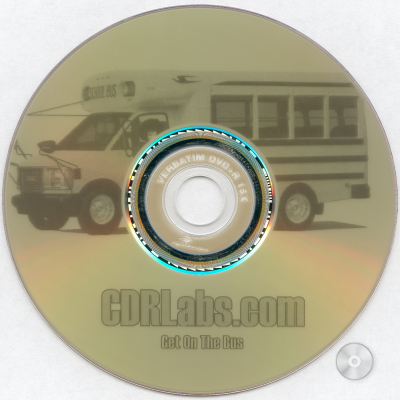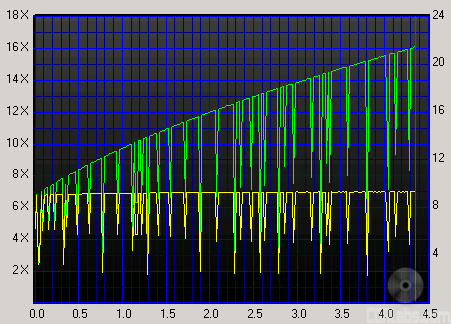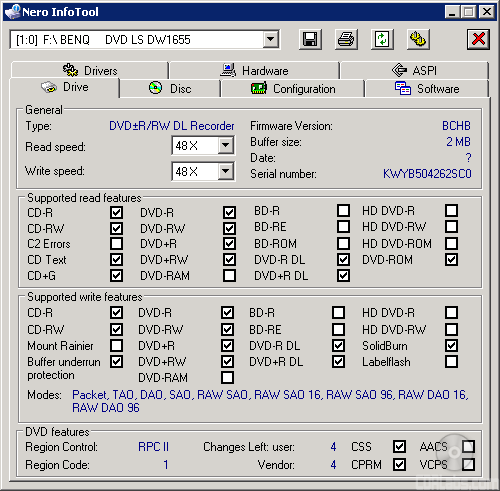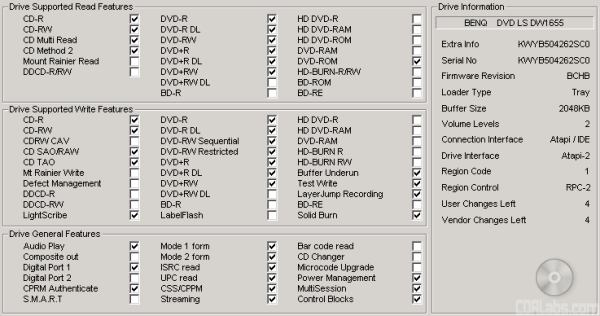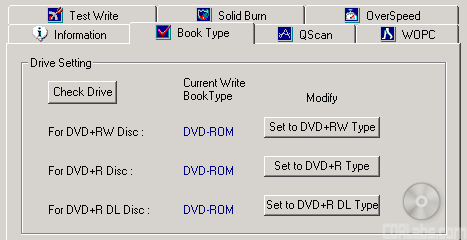What's in the box?:
- BenQ DW1655 16x DVD±RW Drive
- BenQ Software Disc v2.4
- Hardware Quick Start Guide
- Software Quick Start Guide
- 1 Verbatim LightScribe 52x CD-R Disc
- Mounting Screws
- Warranty Information
Physical Features:
The drive BenQ sent us for this review was manufactured in November of 2005 and had firmware version BCAB. For this review we used firmware version BCHB.

From the front, the DW1655 looks very similar to BenQ's previous 16x DVD±RW, the DW1640. Both drives share the same basic design and have many of the same logos. Along with the large "BenQ" logo, you can see a few showing support for DVD+R DL, DVD-R/RW and Ultra Speed CD-RW media as well as technologies like LightScribe and SolidBurn.

Below the tray you can see the DW1655's single LED. Off by default, this LED lights up green whenever the drive is reading or writing.
The rear of the DW1655 looks very similar to some of the other BenQ based DVD writers we've reviewed. By looking at the picture below you can see the drive's IDE interface, power connector and analog audio output connector.
Starting from the left of the IDE connection you'll see the jumper switch for master, slave and cable select. By default it comes set as master. Next to the jumper block is the analog audio connector. The connector on the far left is the digital audio output.
Technical Specs:
The specs below have been taken from BenQ's website and the box that the drive came in.
| BenQ DW1655 16x DVD±RW | |
| CD Write Speeds | 48x, 40x (CAV) 32x, 24x (P-CAV) 16x, 12x (CLV) |
| CD Rewrite Speeds | 32x, 24x (P-CAV) 16x, 10x, 4x (CLV) |
| DVD+R Write Speeds | 16x (CAV) 12x, 8x (P-CAV) 4x, 2.4x (CLV) |
| DVD+RW Write Speeds | 8x (Z-CLV) 4x, 2.4x (CLV) |
| DVD-R Write Speeds | 16x (CAV) 12x, 8x (P-CAV) 4x, 2.4x (CLV) |
| DVD-RW Write Speeds | 6x, 4x, 2.4x (CLV) |
| DVD+R DL Write Speeds | 8x (P-CAV) 4x, 2.4x (CLV) |
| DVD-R DL Write Speeds | 4x (CLV) |
| CD Read Speeds | 48x Max (CD-ROM/CD-R) 40x Max (CD-RW) |
| DAE Speeds | 48x Max |
| DVD Read Speeds | 16x Max (DVD-ROM Single Layer) 12x Max (DVD-ROM Dual Layer) 16x Max (DVD±R) 12x Max (DVD±RW) 12x Max (DVD±R DL) |
| Buffer Size | 2 MB |
| Access Times |
120 ms (CD) 120 ms (DVD) |
| CD Formats | CD-DA CD-ROM CD-ROM XA CD-R CD-RW Bootable CD Video CD Super Video CD Photo CD CD-Text CD Extra Mixed Mode |
| DVD Formats | DVD-ROM DVD-Video DVD+R/RW DVD-R/RW DVD+R DL DVD-R DL |
| CD Recording Modes | Track At Once Session At Once Disc At Once Fixed and Variable Packet Writing Direct Over Write (CD-RW) Simulation Writing |
LightScribe:
Note: We took a much closer look at LightScribe technology in our review of the BenQ DW1625. In this review we'll just go over some of the basics and see how the DW1655 performs with the bundled software.
The DW1655 is the second drive from BenQ to feature LightScribe technology. Developed by HP, LightScribe lets you burn durable, silk screen quality labels directly onto your CD's and DVD's using the same drive that burned the data. According to HP, it's as simple as burning the data, flipping the disc, and then burning the label.
Of course you can't do this with just any drive, media or software. While LightScribe capable drives use the same laser when burning both the data and label, they have to be able to accurately control the laser's focus and position as well as the spindle speed. They also must be able to recognize LightScribe media. These special discs have a thin dye coating on the label side that absorbs laser light. This triggers a chemical reaction that produces a color change, allowing the user to print text, artwork or graphics.
Even if you have a LightScribe capable drive and media, you will need software that supports it. Most major software companies have pledged support for the technology. However, at the time of this review, the list of compatible software is still relatively short. For the DW1655, BenQ turned to Nero. Using the bundled software you can both create and burn LightScribe disc labels.
Once you've created your LightScribe label, you're ready to print it. Before you can do this though, you will need to choose the contrast. Keep in mind this option not only changes the level of detail, it also affects the amount of time it takes to print the label. The higher the quality, the longer the process will take.
How long does it take to print a label? For testing purposes, we created a few discs using Verbatim's LightScribe v1.2 CD-R and DVD+R media. In both cases, the quality has been set to "best". The results are shown below.
Write Right Technologies:
The DW1655 features what BenQ calls their "Write Right Technologies." Consisting of WOPC II (Walking Optimal Power Control II) and Tilt Control, these technologies work together to deliver the best writing quality possible.
WOPC II - In the past, drives would use a preset writing strategy and stick to it throughout the entire burning process. That's not the case with BenQ's WOPC II technology. It constantly monitors and evaluates writing quality, adjusting the writing power in order to ensure the best writing quality possible over the entire disc.
The screen shot below shows WOPC II in action. The dips in the graph indicate where WOPC II has adjusted the writing power of the laser.
With the DW1655, BenQ has also implemented BLER OPC (Block Error Rate Optimal Power Control). Similar in function to WOPC II, this technology enhances the writing quality near the end of the disc to prevent any warping or other potential problems.
Tilt Control - The best reading and writing quality occurs when the angle between the disc and laser is 90 degrees. If a disc is warped though, the laser beam will not be positioned correctly. To remedy this, BenQ developed Tilt Control technology. With this technology, the DW1655 can reposition the OPU (Optical Pickup Unit) to maintain a 90 degree angle between the disc and laser.
SolidBurn:
BenQ's new DVD writer also features their SolidBurn technology. Activated by default, SolidBurn automatically creates writing strategies for unknown, or unsupported, DVD±R media. Simply insert your disc and burn. The new writing strategy is then created on-the-fly.
SolidBurn also works with supported media. When activated, the drive will ignore the writing strategy stored in the firmware and instead create a new one. This is very useful if you are trying to record a disc that uses another company's MID code (I.E. fake TYG02 code discs).
OverSpeed:
The DW1655 also supports BenQ's OverSpeed function. When enabled, the drive will try to write to 4x or 8x DVD±R media at 8x or higher. In order to make the process more likely to succeed, SolidBurn is automatically activated when this function is used.
More Features:
By looking at the picture below, you can see that BenQ's new DVD writer is identified as a "BENQ DVD LS DW1655."
The Nero screenshot also shows that the DW1655 has a maximum CD writing speed of 48x and a 2048KB buffer. This buffer is backed up by BenQ's Power-Burn buffer underrun protection. According to Nero, the DW1655 can write CD-Text and overburn. When testing the drive's capacity, it had no problems overburning up to 99 minutes with our CompUSA media.
Using Alex Noe's Weak Sector Utility we were able to determine that the DW1655 is a "no sheep" burner. This means that the drive is not a very good choice if you plan to back up titles protected by SafeDisc 2 or later.
Here is a screen shot from Nero's InfoTool. This program queries the drive to see what its reading and writing capabilities are. InfoTool had no problems detecting the DW1655's maximum reading and writing speeds, recording modes, buffer underrun protection and 2MB buffer.
InfoTool also shows that the DW1655 is an RPC-2 DVD drive. This means that the drive's region is stored in the firmware. The drive's region can be changed five times and after that it cannot be changed anymore. A patched RPC-1 firmware can be downloaded here. Just keep in mind that it is not supported by BenQ nor by CDRLabs. Use it at your own risk.
While InfoTool gives us a quick glance at the DW1655's features, DVDINFOpro provides a little more information on some of the drive's reading and writing capabilities. By looking at the screenshot above you can see that while BenQ's new drive can read and write to both DVD+R DL and DVD-R DL media, it does not support the Mt. Rainier format.
The DW1655 also supports a feature called "bitsetting." Using CD Speed or BenQ's QSuite utility you can set the book type for DVD+R, DVD+RW and DVD+R DL media. By doing so, your recorded discs will identify themselves as "DVD-ROM." This feature comes in handy if you have an older DVD player that has problems playing recordable media.





